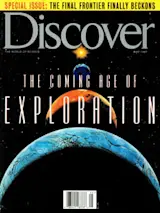A little more than a year ago, I participated in a meeting, organized by the National Academy of Sciences, on the subject of enhancing public understanding of science by encouraging greater collaboration between scientists and the media. Most of the scientists present were members of the academy, which serves both as an elected honor society and as an official adviser on science policy to the U.S. government. Across the room I spotted a slim man who seemed somehow familiar. His deliberate movements suggested an inner passion concealed beneath a subdued exterior. When I came close enough to read his name tag, I saw that he was the famous astronomer Carl Sagan, whom I had corresponded with but never met.
We introduced ourselves and began a conversation that strikes me now as poignant. Sagan mentioned having heard that I’d developed a potentially lethal cancer, and he asked how I was doing. I replied that I had undergone surgery and was now fully cured, as far as I knew. He volunteered that he, too, had had a brush with cancer. He had been diagnosed with myelodysplasia, a condition that can develop into leukemia, but he had received treatment and, he said, been cured. Unfortunately, not long after our meeting he developed complications from a bone-marrow transplant and died a few days before Christmas. I wonder, in retrospect, whether he owed his subdued appearance the day we met to a sense of what was to come.
Later that day, during a group discussion about the importance of communicating science to the public, I commented on a disturbing paradox: scientists who do communicate effectively with the public often find their colleagues responding with scorn, and even punishing them in ways that affect their careers. My remarks stimulated Sagan to address the meeting eloquently for 15 minutes. He described how he, too, had taken flak from other scientists, but--he paused, as if to choose his words carefully--the disadvantages to him had for the most part not been serious. As he uttered these words, I sensed my fellow academy members holding their breath, waiting to hear whether Sagan would mention a stinging insult he had suffered at the hands of academy members themselves. In fact, he passed tactfully over the scandal that had unfolded a few years earlier, when he had become one of the few people in the academy’s long history to have been provisionally elected to membership but then individually rejected in a special vote.
Sagan’s rejection would normally have remained unknown outside the academy, because members are supposed to keep election matters secret. Some unidentified members, however, were so outraged that they leaked the affair to the press. (I have no idea who they were, having missed that meeting.) Briefly, as described in the press, Sagan had been among many scientists nominated, his candidacy survived initial screening stages, and his name was on a long list of candidates placed on the ballot mailed to academy members. Ballot responses placed him among the 60 candidates receiving the most votes. These top candidates are usually accepted as elected, without further discussion, at the annual meeting.
In this case, however, Sagan’s provisional election was singled out and challenged on the floor of the meeting. By academy rule, a nominee thus challenged is dropped unless his or her candidacy is sustained by at least two-thirds of the members present and voting. After a heated debate, more than a third voted to repudiate Sagan’s election. That rare slap in the face ended his candidacy.
Over the last two decades, more than a thousand scientists have been elected to the academy, but I recall only one other candidate repudiated and few others even unsuccessfully challenged. Much of the opposition on the academy floor was framed in terms of procedural issues, or of Sagan’s allegedly deficient contributions to scientific research. Undoubtedly, some of his opponents did indeed hold a low opinion of his contributions. However, Sagan’s research was well known and obviously deemed important enough by academy members for them to provisionally elect him in the first place. He deserved much of the credit for explaining Venus’s peculiar atmosphere, the changes in the appearance of Mars (due to dust storms, not canals or seasonal changes in vegetation, as previously assumed), the greenhouse effect on Earth and Venus, the origins of organic matter on Earth, and the conditions for extraterrestrial life. He also played a big role in the Mariner, Viking, Pioneer, Voyager, and Galileo missions that transformed our understanding of all the outer planets.
It may well be that Sagan lost his potential seat in the academy not because he failed to produce sufficient important scientific research but because he had too much success as a popularizer of that research. To the public, Sagan was by far the most famous American astronomer and one of the most famous American scientists in any discipline. That fame arose from his unique skills in explaining science to the public. When it first aired in 1980, his television series Cosmos attracted more viewers than any other public tv series before it, and it continued to hold that record for years. It did more than anything else to arouse public interest in astronomy and public support for nasa’s expensive program of planetary probes. But Sagan’s communication skills paradoxically provoked a backlash among many scientists, who refused to believe that he could simultaneously be a serious scientist and a charismatic tv personality.
What makes the academy’s rejection of Sagan so tragic, and initially so incomprehensible, are all the valid reasons that scientists themselves regularly adduce to explain why it is so important for the public to understand science. I see at least five such reasons, and it is worth detailing them so that we can appreciate why the attitudes revealed in Sagan’s rejection by the National Academy of Sciences pose such a big problem.
First, science isn’t something arcane, intended only for the few. Every one of us--whether a poet, janitor, or nuclear physicist--has to be able to think scientifically, and to understand some science, to get through our lives. Every day we face decisions that hinge on science, such as whether to smoke, what to eat, with whom to have sex, and what protection to use (if any). Even for decisions that don’t depend on specific scientific facts, science remains the proven set of best methods for acquiring accurate information about the world.
Second, some of us end up as policymakers in government or business. These individuals make decisions that fundamentally affect the well-being of everyone, and most of them know no more about science than does the rest of the general public. Yet they are called upon to decide what to do about (and how much money to spend on) nuclear reactors, global warming, environmental toxins, expensive space programs, biomedical research, and applications of biotechnology. It’s nonscientists, not scientists, who have the last word on whether the milk we drink can safely come from cows treated with growth hormones. To make such decisions wisely, the decision makers have to be drawn from a scientifically educated public.
Third, as voters, we all bear the ultimate responsibility for those decisions, because we are the ones who decide which candidates and which ballot measures will prevail. We need enough sense about science to select the decision makers who will make good choices when faced with scientific questions.
Fourth, even if science were irrelevant to the lives of ordinary Americans, a strong scientific enterprise is essential to our economy, educational system, and society. That requires lots of young people to become excited enough by science that they resolve to become professional scientists. Good communication by scientists to the public is essential to spark that excitement.
Finally, scientists themselves should be interested in promoting public understanding of science for a selfish reason: their salaries and research grants depend on the nonscientists who hold the purse strings in Congress, state legislatures, and private foundations. Those money givers reach their decisions based on how important they think science is.
All these arguments demanding the public’s understanding of science are ones that scientists correctly lay out, and grasp better than anyone else. You might therefore expect them to give every possible support and incentive to those few scientists who, like Carl Sagan, devote much of their effort to fostering that understanding. Paradoxically, though, popularizers face widespread indifference, hostility, and penalties, such as honors and promotions delayed or even denied. Sagan’s rejection by the academy was just a well-publicized example.
As a result, those scientists who do communicate well are overwhelmingly at a senior stage in their careers. They wait until they have tenure and are thereby better able to withstand their colleagues’ hostility. Young or nontenured scientists are relatively mute before the public because they realize that to be otherwise could mean the kiss of death. Yet it is especially important for young scientists to be effective communicators because they are the ones most active in research, least diverted by administrative responsibilities, and the best role models for young people.
Of course, these sweeping generalizations conceal exceptions. How popularizers are viewed by their peers seems to vary among fields of science. They are more readily accepted or even admired in evolutionary biology (for example, Stephen Jay Gould) and medical science and molecular biology (Lewis Thomas), but are much fewer in number and more poorly tolerated in chemistry, mathematics, and astronomy (Carl Sagan). How you do it also makes a difference: popularizers who vividly project their own persona (Sagan again) are less well tolerated than those who focus on the scientific discoveries themselves (for example, Richard Dawkins); those whose intended audience is the whole public (Sagan again) get more flak than those aiming mainly at university students (Richard Feynman). But the paradoxical trend remains, and it demands explanation. Why do scientists exhibit so much indifference or hostility toward colleagues who advance the interests of scientists as well as of the public?
For one thing, communicating to the public and to one’s fellow scientists requires very different styles. When we write research articles for our colleagues, we are trained to avoid simplification; to be precise, using technical terms, inserting all appropriate qualifiers (if, but, maybe), and supplying all relevant details; to avoid vivid, poetic language, which suggests that we seek to convince by slick words rather than by correct arguments; to write impersonally, replacing the first person (I did the experiment) with the third person (The author did the experiment) or the passive voice (The experiment was done), because science is supposed to be about the truth rather than about one’s ego; and to give exhaustive credit to colleagues, lest we seem to be claiming undeserved credit.
Naturally, if we were so foolish as to submit an article written in that style to a magazine intended for the general public (like Discover), it would go straight into the wastebasket--and for good reason, because it would be boring and hard to understand. Instead scientific explanations aimed at the public must be succinct, direct, and vivid. When we write for a popular audience, we must use nontechnical language and speak in the first person, simplifying if necessary to make our points clear. It’s hard for us scientists to reverse a lifetime of programming and applaud a colleague who writes in a way that we may have worked long and hard to suppress. It inflames us to see a colleague violating all these rules of academic writing and getting away with it.
Scientists, being human, are also understandably jealous about all the attention that effective popularizers receive. As Carl Sagan put it, A scientist who devotes his life to studying something arcane like the hyperfine structure of the molybdenum atom, and whose work is ignored by everyone except the world’s three other experts on molybdenum, naturally is jealous and outraged to see reporters hanging on me for my latest pronouncement about the possibility of extraterrestrial life.
Finally, scientists tend to assume that any colleague who does stoop to explain his or her work to the public is all washed up as a serious scientist and is doing this because he or she is no longer capable of doing real science. It’s true that popularizers do tend to be older scientists, but again that’s because younger scientists fear career ruin.
Public puzzlement is not the only unfortunate result of scientists’ aversion to writing and speaking comprehensibly. There is another tragedy, one that has received much less attention: most scientific writing is incomprehensible even to scientists, except for specialists in the author’s narrow field. Let me illustrate this with a typical example involving just one recent research article. I selected it almost at random from hundreds of thousands of research articles published each year. I picked this particular one because it’s from one of the two most influential scientific journals in the world, supposedly devoted to wide communication among scientists. That’s the journal Science, the weekly publication of the American Association for the Advancement of Science (aaas, the umbrella organization of all American scientists from physicists to psychologists). Science publishes articles spanning the whole spectrum of fields. According to the masthead, Its [aaas’s] objectives are to further the work of scientists, to facilitate cooperation among them...and to increase public understanding and appreciation of the importance and promise of the methods of science in human progress. Science’s instructions to prospective contributors state, Submitted manuscripts should be intelligible to readers in a variety of disciplines.
I opened a recent issue of Science and arbitrarily chose an article halfway through the magazine’s 15 research reports. The table of contents gives the title: Activation of sapk/jnk by tnf Receptor 1 Through a Noncytotoxic traf2-Dependent Pathway. In that entire title the word noncytotoxic is my sole clue as to the subject of the article. Cytotoxic means poisonous to the living cells that make up a plant’s or animal’s body. Hence I am now confident that the field within which the article’s subject falls isn’t physics or psychology but cell biology. Since I have been a professional biologist for 39 years and my research fields include cell biology, I am much more likely to be the article’s intended reader than most other scientists. Nevertheless, I have never even heard of sapk, jnk, tnf, traf2, or their receptors or pathways, so I have not the faintest idea what the article is about. The title gives me no reason to suspect anything interesting, important, or relevant to my own work. Ordinarily, I would skip such an incomprehensible article.
I turned to page 200 and read the report’s first sentence: Interaction of the p55 tumor necrosis factor receptor 1 (tnf-r1)- associated signal transducer tradd with fadd signals apoptosis, whereas the tnf receptor-associated factor 2 protein (traf2) is required for activation of the nuclear transcription factor nuclear factor kappa B. That sentence introduces more unfamiliar terms (p55, tradd, fadd, apoptosis--most remaining undefined throughout the article). It contains a string of nine nouns and noun-adjectives (p55 . . . tradd) in which I have difficulty figuring out which noun is being used as an adjective to modify which other noun, and another string of five nouns and adjectives (nuclear transcription factor nuclear factor) about which I am in doubt whether the repetition is intentional or a printer’s error. I finally realized that definitions of the acronyms tnf and traf are buried within the sentence (try to find them yourself), so I went on to read the rest of the short report, but in the end I still didn’t know what it was about.
I am not singling out this report to ridicule it or to brand it as exceptional. Most reports in almost any other scientific journal would have made my point equally well. Instead I cite it as a completely typical example of that second tragedy--that even scientists can’t possibly understand most articles written by scientists. Perhaps the sapk/jnk report reveals something that would let me make a breakthrough in my own research. But I would never know it unless I made a time-consuming effort to understand the report (for example, by asking a colleague to explain it to me, or by reading a lot of background material in textbooks). I’m not going to spend that time, because thousands of scientific reports are published every week, and I can’t afford to waste more time on this particular one. Instead I move on in search of something that I can understand and whose possible relevance to my interests I can recognize.
Unfortunately, great scientific advances come especially from applying discoveries in one field to another field entirely. If atomic physicists hadn’t taken their discovery about the instability of carbon atoms with an atomic weight of 14 and applied it to ancient Egyptian textiles, for example, we wouldn’t have the radiocarbon dating method. Research described incomprehensibly loses much of its value because people are likely to overlook possible applications of it outside the immediate field.
It’s sad that scientists erect such enormous obstacles. It would be so easy to solve the problem--for instance, we could publish 20 percent fewer reports but increase their comprehensibility 10,000 percent merely by devoting 20 percent of the length of each published report to defining terms and introducing the subject for scientists from other fields. Nature, the British equivalent of Science, recently ran an editorial addressing the readability problem and recommending just these sorts of solutions. Authors, wrote the editors, might ask colleagues outside their fields to read their articles. They should at least respond positively when Nature’s editors prod them to remove the nth unexplained acronym in their first paragraph.
Carl Sagan would have done better at explaining sapk/jnk activation, whatever it is. As Lewis Thomas showed us, it’s as feasible to explain things clearly in cell biology as it is in astronomy. But virtually every American scientist learned of Sagan’s rejection by the National Academy and of other consequences of popularizing science. Every scientist is capable of recognizing the obvious implications for his or her self- interest.
As a result, the task of explaining science to the public has been largely delegated to science journalists who are not practicing scientists. Even Science uses journalists to explain recent scientific advances to scientists, in an introductory section termed Research News. Yet journalists, no matter how gifted they are, can’t replace scientists themselves as role models for young people contemplating a career in science, or as advocates before Congress at times of budget hearings, or just as the people most knowledgeable about their subjects. That takes someone like Sagan.
Of course, there will never be another Carl Sagan, and his loss seems doubly painful because we so badly need scientists with his skill. Just one would not be enough: we need thousands. But we are never going to get them--not until scientists and their organizations drastically change their behavior.














